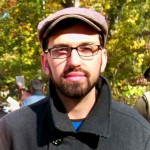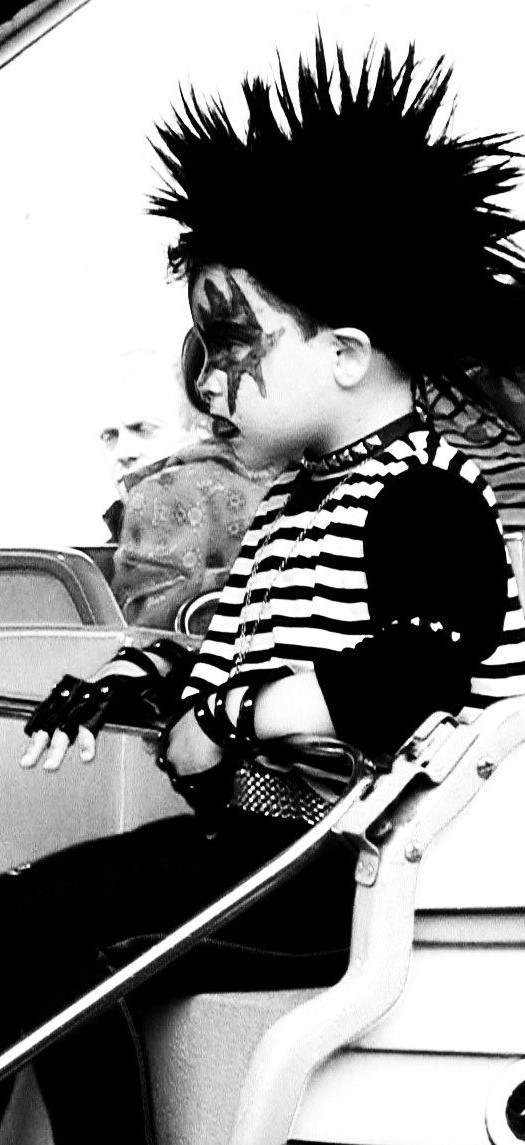Brian  Mihok’s work has appeared or is forthcoming in Vol. 1 Brooklyn, Necessary Fiction, Hobart, 1913 and elsewhere. His novel The Quantum Manual of Style will be released in February 2013 by Aqueous Books. He co-edits matchbook, a journal of indeterminate prose.
Mihok’s work has appeared or is forthcoming in Vol. 1 Brooklyn, Necessary Fiction, Hobart, 1913 and elsewhere. His novel The Quantum Manual of Style will be released in February 2013 by Aqueous Books. He co-edits matchbook, a journal of indeterminate prose.
Brian, The Quantum Manual of Style is quite a unique novel, with its manual-like style guide and hypothetical teaching examples woven into the broader narrative. What inspired such a construction? Do you have a background in science? In quantum mechanics?
It started with two unrelated ideas. I had just moved to Buffalo and because I didn’t know anyone other than my girlfriend, who was in grad school at the time, I was afforded a lot of time to read and write. She would come home late and do homework until she went to bed so it was like being in love with someone who is actually out of town. Still, she brought home all these style guides, APA, MLA, whatever-A. Big fat guidebooks to teach a student the relatively unimportant yet technical details of adhering to expected academic usage. The books would sit there during the day and stare at me long enough until I opened them up and flipped through. At some point it occurred to me that it might be interesting to see a book of fiction that looked like one of them. Something kind of ridiculous and over-the-top. Something that purported to give simple rules to simple problems, but was really ideologically a mess of ideas and reasons and examples. That was one idea.
The other idea stemmed from the fact that I had myself just graduated grad school and needed something new on which to work. My thesis had been a novel, but it too was a mess and I realized that I might be beyond it. I was vulnerable as a writer, willing to take a risk. Do something I hadn’t done before. I bought an old book called Cosmology: A Class Manual in the Philosophy of Bodily Being by Paul J. Glenn. It’s a strange book of philosophy that toys with a pseudo-scientific approach to understanding the universe and our place in it. It’s full of beautiful language and that is what intrigued me about it. I decided to either make an erasure poem out of it, or else take phrases, lines from it and re-purpose them. It was an unformed but propulsive idea that many poets utilize. It excited me.
Then, for no conscious reason, the two ideas melded. At some point I was saying something like, “I could write a book of rules inspired by this strange scientific language or something.” Also I had been reading a lot of pop science articles on quantum physics. I have no background in science but I love science. I find it full of beauty. Quantum science is as bizarre as reality gets, yet the more I learned about it, the more I saw parallels with how our day-to-day world works. So I just wrote through that observation. I knew that because it was a book of fiction, I didn’t even need to get the science right but that said I did still try to get the science mostly right because the science itself can be as fascinating as anything, especially how things are written. But really the novel isn’t about science anyway.
How did you go about writing the novel? Was either the protagonist’s story or manual portions of text written in its entirety first, or were they interspersed from the outset?
With some exceptions the book was written straight through. I would write a rule in the context of this imagined discipline called quantum style. Then I would explain what the rule means. Then I’d give an example or examples of it in practice. For the form I borrowed heavily from Strunk and White’s The Elements of Style because, flaws or no, I find it organizationally to be a striking book. The organization is clean and methodical. I tried to use this as a model. At first I didn’t think there would be just one main narrative that carried the book. I assumed it’d be more like a collection of short stories tied together with this artifice of quantum style. And while there are several small stories set as examples, there is in fact a dominant story that travels the length of the book. I think this is what makes it a novel.
The tone of the prose ranges from clinical to poignant to funny and quirky. Can you describe how you’ve gone about creating the novel’s voice?
The voice was exciting for me because I was able to let a certain part of my brain go completely unchecked. It was the part that dissects and orders the universe according to size or shape or taste or color. It was the math part. Of course normally that part has to be constantly reined in when I’m writing fiction because ultimately the most important part of a story is how it makes the writer and the reader feel, not whether the equations are balanced. But there was something to letting the equations get balanced in words, while at the same time skewing them a bit. Tempering them with oddity and aesthetic juxtaposition. I let the examples be more of a “fictional” voice, as in a voice one might expect to encounter in a piece of literary fiction, so as to have a break from the rule thing, and to add dimension to the manuscript.
How long did it take you to write The Quantum Manual of Style? Surely, it was a worthwhile experience, but was it a fun one as well?
About a year. Roughly six to eight months for the first draft. Then another six or so for revision. Yes, it was a lot of fun to write; otherwise, I might not have finished it. I find that once I stop enjoying a project, for better or worse, its days are numbered.
Congrats on the book’s forthcoming publication by Aqueous Books! Can you discuss the process that led them to pick up the novel, and share the news about its release?
Thank you. I had had a couple short pieces published by Aqueous’s journal Prick of the Spindle and I thought both POTS and Aqueous were doing good work so I sent in the manuscript for consideration. One day I got an email from Cynthia, the publisher, saying she was enjoying it but would I send another copy without all the apparent track changes. This was alarming for two reasons: one, because I don’t use track changes and had never them turned on, so it confused me as to why they were showing up; and two, being an actively publishing writer means going over a potential story or manuscript hundreds of times before sending it off, so having a journal or press read your work in some form you didn’t intend is, well, horrible. Still, she emailed a couple weeks later (after I sent the requested “clean” copy) to say she loved it and wanted it. There is a lot of work left to be done before it is a physical object, but it’s due out this February, which is exciting!
Thanks, Brian. Is there anything else you’d like to mention or explain to readers?
One thing I’ll add is that I’ve been thinking about ways to get the book into people’s hands. One idea–which is really not a way to get it into people’s hands, but is a way for me to have a laugh and hope someone not in the literary world will care–is that I have a spreadsheet of physicists to whom I am going to send copies of the book. I wonder if they would find it interesting since it is a book that uses the language and ideas of their profession to tell the story of a family and their troubles. I figure maybe I’ll get lucky and one of them will read it. That would make me pretty happy.
